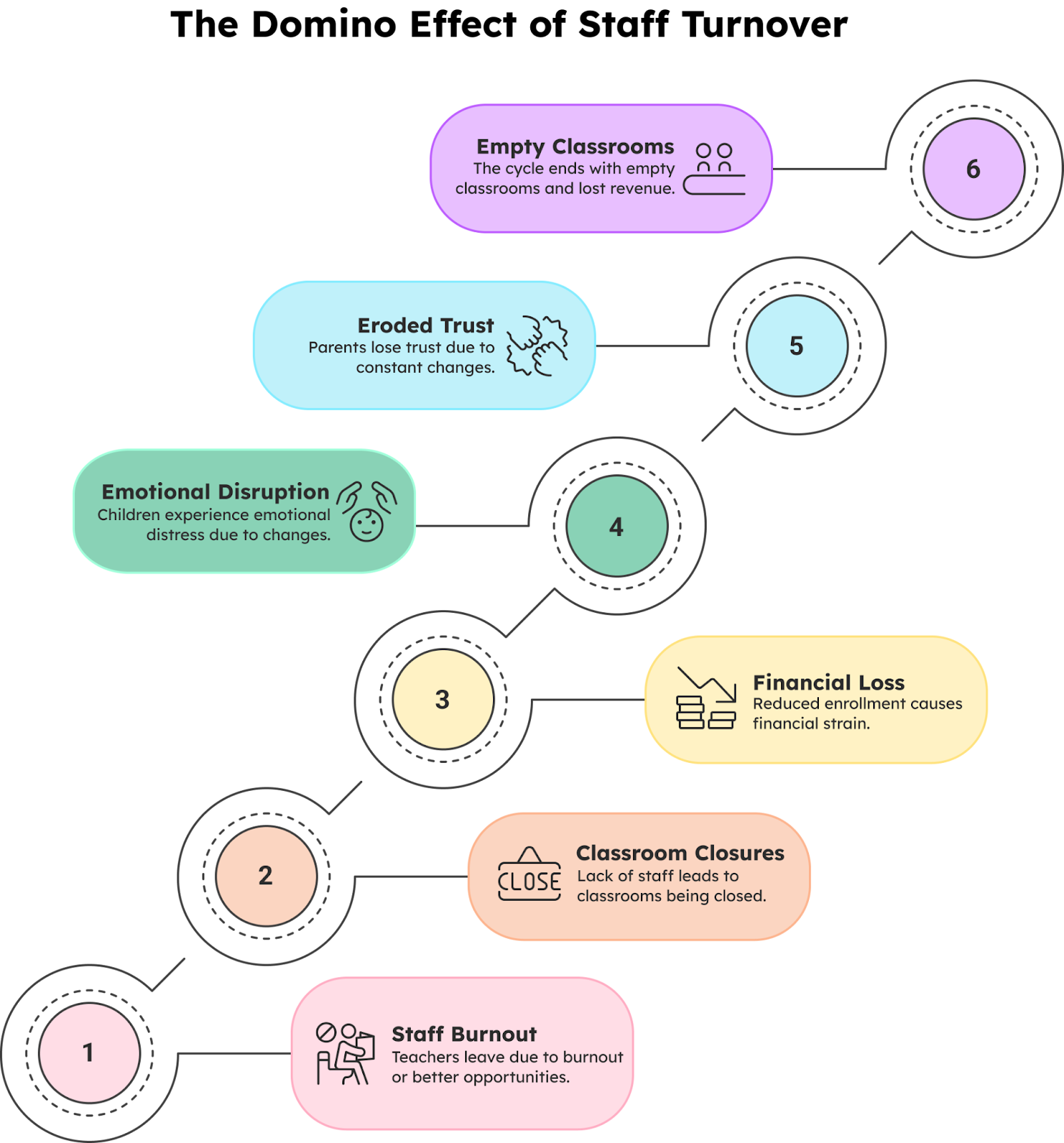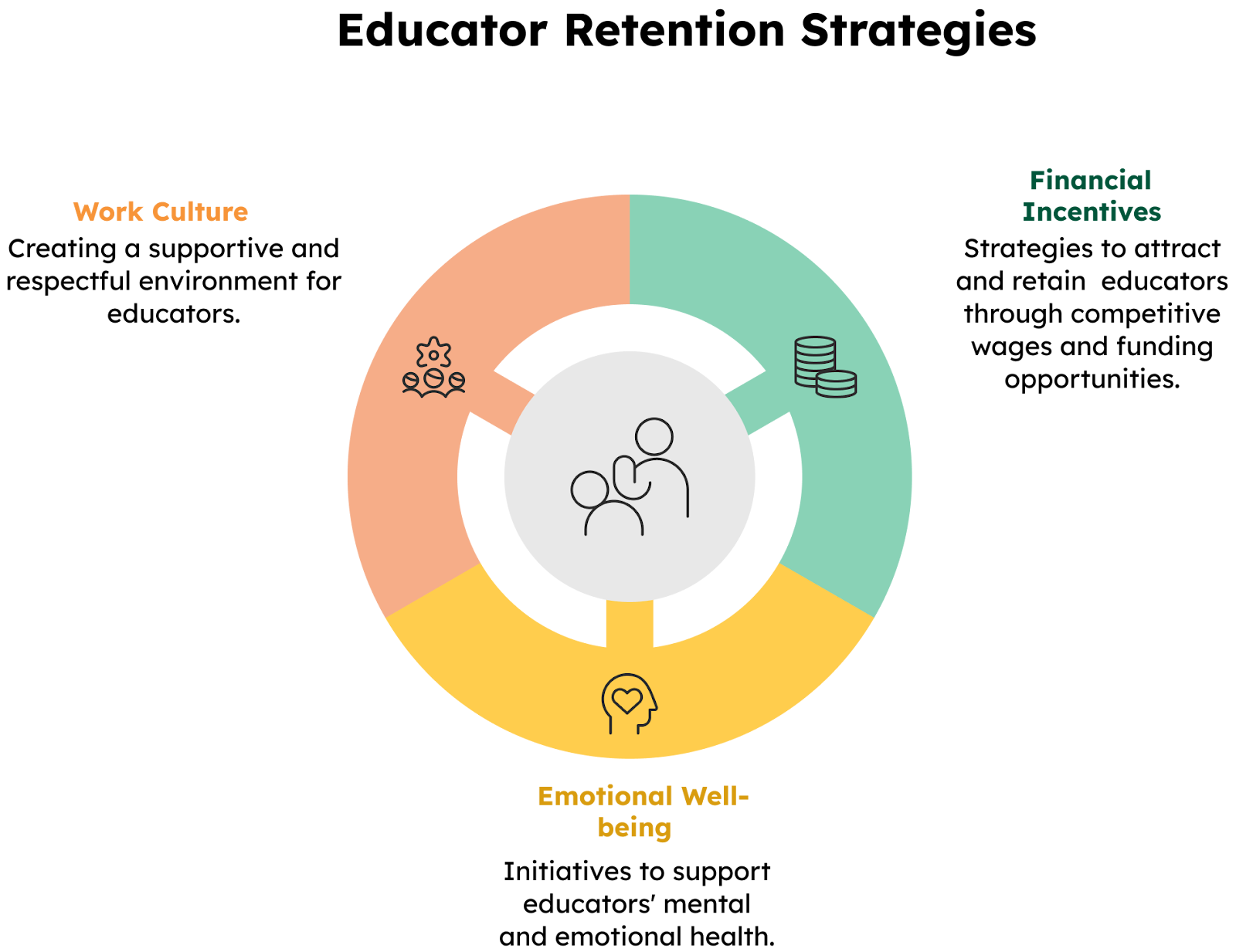On a recent Friday afternoon, a center director whom I know had to close a classroom mid-year.
Her obstacle was staffing.
Three lead teachers resigned in as many months, and she could no longer meet the required ratio. Across the United States, versions of that scene are playing out every day. Child care centers are bursting with demand, yet struggling to keep the group leaders and staff who make quality care possible.
Why Are Teachers and Childcare Staff so Hard to Find for Many Childcare Centers?
It’s no secret that early childhood education struggles with high teacher turnover. But when you dig a little deeper into the why, the story becomes clear. Different studies and the resulting data all point to these underlying issues:
1. Pay that lags while prices rise
The numbers are stark.
The average wage for a child-care worker in Florida hovers around $11.94 an hour. That’sbarely enough to buy a few gallons of gas, a gallon of milk, and a modest lunch break before the paycheck is gone. Even full-time employment at that rate yields roughly $24,800 a year—just above the federal poverty line for a family of three and thousands below Florida’s SNAP eligibility threshold.
Meanwhile, retail and hospitality employers (Florida’s other service-sector giants) have raised entry wages to compete for workers, luring educators who simply cannot stretch a child-care paycheck to cover housing, groceries, and car insurance.
2. The end of relief funding
During the pandemic, federal stabilization grants allowed many centers to supplement salaries and benefits. Those dollars expired in September 2024, stripping away temporary raises and retention bonuses. A Florida Policy Institute analysis warns that 2,196 centers are at risk of closure without new funding streams. Staff see the handwriting on the wall and leave before programs downsize.
3. Emotional burnout
Early educators describe long hours, high licensing expectations, and the weight of being both nurturer and first responder for children’s post-pandemic stress. Unlike K-12 teachers, they often receive no planning time, limited lunch breaks, and minimal professional recognition. The result is a statewide turnover rate that advocacy groups estimate hovers near 40% within the first five years.
The Domino Effect on Children and Your Business
But what looks like just one teacher leaving often triggers a chain reaction.

With fewer qualified staff, classrooms shut down. That means fewer enrollments and more strain on the center’s financial foundation. Meanwhile, children lose consistency. Rotating caregivers can interrupt learning and emotional stability. When parents notice these changes, trust frays. These families leave to seek better care. And when families leave, so does tuition.
The Florida Chamber of Commerce calculates that childcare breakdowns already cost the state $5.4 billion a year in lost productivity and tax revenue.
I’ve seen this happen first hand with one of my clients, and talked about such issues extensively in my webinar with illumine.
Keeping Your Best People: Increasing Educator Retention
Retaining educators is not only a moral imperative, but also a survival strategy. Yes, budgets are tight. But directors who treat staffing like the revenue engine are finding ways to tilt the balance. Based on my conversations with program leaders from Pensacola to Key West, here are the retention strategies I see working in real time.

A. Financial & career incentives
1. Treat wages as a marketing spend, not a cost center
When she compared her teacher wages to local retail ads, a childcare owner in Naples realized she was losing staff to supermarkets paying $2 more an hour. By raising base pay to $14 and trimming seldom-used subscriptions, she filled four vacancies in six weeks and lifted enrollment by ten children, more than offsetting the raise.
Also, remember that salary expectations vary from one community to another. They also change in response to changes in the local economy. In addition to monitoring what other centers and service businesses are doing, try to keep track of the costs your staff incur to live in your area.
2. Leverage State-specific funding streams
Here’s just a few of the state funded programs across the country:
Florida:
- With T.E.A.C.H. Early Childhood® Florida, your staff can get 80% of their tuition and books covered for credentials like a CDA or bachelor’s degree.
Additionally, they earn a bonus when they finish.
- Many Early Learning Coalitions provide Quality Performance Incentive Payments tied to CLASS scores or accreditation. Earmark those funds for staff stipends.
- In the 2025 legislative session, HB 47 proposes easing specific municipal assessments and licensing redundancies. The resulting savings can be redirected into compensation.
California:
- Rate enhancements and local subsidy support from CalWORKS or CCDF helps centers raise staff wages over time (often tied to accreditation or CLASS quality tiers)
- Stipend programs like Childcare Retention Incentive (CRI) can help you staff if they meet tenure or credential thresholds, introduced through the state’s Workforce roadmap
- If the legislation passes it, the 2025 Teacher Recruitment Incentive Grant can help you subsidize wages or bonuses
New York:
- OCFS launched a $500M grant program to support existing staff (bonuses of $2,300–$3,000) and help recruit new hires through retention and sign‑on incentives.
- Child Care Stabilization Grants that were originally used to sustain program capacity and stabilize staffing post-pandemic, can also support retention stipends or bonuses
Texas:
- T.E.A.C.H. Early Childhood Texas Scholarship provides tuition and credentialing support for educators making ≤ $20/hour
- Programs supporting early educator pathways and credential verification via the Early Educator Salary Support Grant also offer incentives for retention and career advancement
- Children’s Learning Institute provides CDA assessment fee reimbursement and provider-level grants. You can leverage these to cover training or staff incentives
3. Create visible career pathways
One center revamped its organizational chart so that every position—assistant, lead, mentor, and master teacher—had a corresponding salary band, required coursework, and a defined timeline. Staff could see precisely how to reach the next tier and what it would mean for their paycheck. Turnover fell by half in a year. Clear pathways signal that early childhood education offers a profession, not just a job.
B. Emotional well-being
4. Celebrate Milestones Publicly
Longevity bonuses—even $250 at a one-year anniversary—signal appreciation. Post certificates earned through T.E.A.C.H. on your lobby wall; parents notice, and teachers beam with pride.
5. Protect mental health
Consider low-cost Employee Assistance Programs, mindfulness apps, or partnerships with local counseling graduate programs for free sessions. Burnout management shouldn’t only be limited to counselling or therapy. Openly normalizing mental health days also reduces the stigma that drives burnout underground. In fact, one Palm Beach County center saw results just by giving staff one "wellness hour" a month for therapy, errands, or rest with no questions asked.
It’s really important to normalize usage like this. When directors model and support emotional well-being, burnout becomes less of a threat.
C. Work culture
6. Build time for professional connection
Weekly all-staff huddles, peer observations, and scheduled planning blocks help educators feel supported and prepared. A Collier County program facing a severe shortage found that dedicating one floating substitute per building to release teachers for 45-minute planning slots cut sick-day use by 30%, citing reduced stress and better classroom management.
7. Offer flexibility and respect
One Miami director surveyed her staff and discovered that three valued a four-day schedule over a raise. She rearranged ratios and offered 10-hour shifts, which cost nothing but boosted retention. Small gestures such as control over classroom décor, public recognition, or a quiet break room,—add up to a culture where educators feel valued and seen.
The staffing crisis is solvable, but only if center leaders act with urgency and creativity.Start by running the numbers. You only need to stick to the basics:
- Run the numbers. What does turnover actually cost your center? Factor in everything: job ads, background checks, onboarding time, overtime for remaining staff, lost tuition from closed classrooms. Seeing that dollar amount in black and white can shift how you think about raises, bonuses, or incentives.
- Ask your people. Send a short, anonymous survey asking: “What’s the one thing that would make you stay longer?” You might be surprised—sometimes it’s not about pay. Sometimes it’s prep time, support, or flexibility.
- Pilot small. Choose one idea, try it for 30 days, and track the difference in attendance, morale, or retention. No need to overhaul your whole budget—just start somewhere.
Florida’s children cannot thrive without consistent, caring adults. Nor can your business. Invest in your people, and they will return that investment in loyalty, expertise, and classrooms full of joyful learners. The path to stability begins with the next conversation you have with the educators already in your building. Ask them what they need and be prepared to listen.


.png)







.webp)